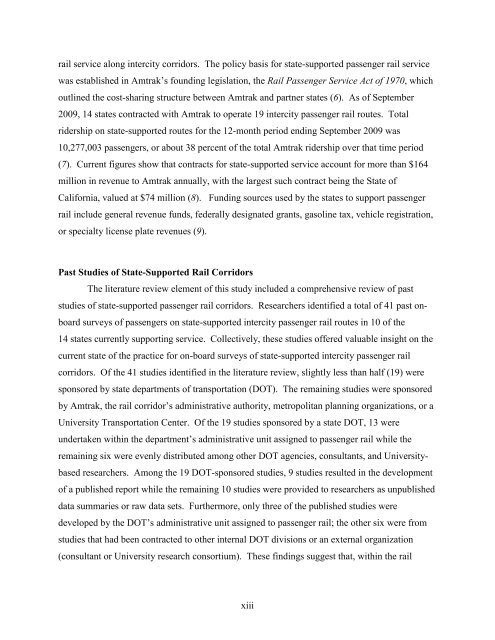Measuring the Benefits of Intercity Passenger Rail: A Study
Measuring the Benefits of Intercity Passenger Rail: A Study
Measuring the Benefits of Intercity Passenger Rail: A Study
Create successful ePaper yourself
Turn your PDF publications into a flip-book with our unique Google optimized e-Paper software.
ail service along intercity corridors. The policy basis for state-supported passenger rail service<br />
was established in Amtrak’s founding legislation, <strong>the</strong> <strong>Rail</strong> <strong>Passenger</strong> Service Act <strong>of</strong> 1970, which<br />
outlined <strong>the</strong> cost-sharing structure between Amtrak and partner states (6). As <strong>of</strong> September<br />
2009, 14 states contracted with Amtrak to operate 19 intercity passenger rail routes. Total<br />
ridership on state-supported routes for <strong>the</strong> 12-month period ending September 2009 was<br />
10,277,003 passengers, or about 38 percent <strong>of</strong> <strong>the</strong> total Amtrak ridership over that time period<br />
(7). Current figures show that contracts for state-supported service account for more than $164<br />
million in revenue to Amtrak annually, with <strong>the</strong> largest such contract being <strong>the</strong> State <strong>of</strong><br />
California, valued at $74 million (8). Funding sources used by <strong>the</strong> states to support passenger<br />
rail include general revenue funds, federally designated grants, gasoline tax, vehicle registration,<br />
or specialty license plate revenues (9).<br />
Past Studies <strong>of</strong> State-Supported <strong>Rail</strong> Corridors<br />
The literature review element <strong>of</strong> this study included a comprehensive review <strong>of</strong> past<br />
studies <strong>of</strong> state-supported passenger rail corridors. Researchers identified a total <strong>of</strong> 41 past onboard<br />
surveys <strong>of</strong> passengers on state-supported intercity passenger rail routes in 10 <strong>of</strong> <strong>the</strong><br />
14 states currently supporting service. Collectively, <strong>the</strong>se studies <strong>of</strong>fered valuable insight on <strong>the</strong><br />
current state <strong>of</strong> <strong>the</strong> practice for on-board surveys <strong>of</strong> state-supported intercity passenger rail<br />
corridors. Of <strong>the</strong> 41 studies identified in <strong>the</strong> literature review, slightly less than half (19) were<br />
sponsored by state departments <strong>of</strong> transportation (DOT). The remaining studies were sponsored<br />
by Amtrak, <strong>the</strong> rail corridor’s administrative authority, metropolitan planning organizations, or a<br />
University Transportation Center. Of <strong>the</strong> 19 studies sponsored by a state DOT, 13 were<br />
undertaken within <strong>the</strong> department’s administrative unit assigned to passenger rail while <strong>the</strong><br />
remaining six were evenly distributed among o<strong>the</strong>r DOT agencies, consultants, and Universitybased<br />
researchers. Among <strong>the</strong> 19 DOT-sponsored studies, 9 studies resulted in <strong>the</strong> development<br />
<strong>of</strong> a published report while <strong>the</strong> remaining 10 studies were provided to researchers as unpublished<br />
data summaries or raw data sets. Fur<strong>the</strong>rmore, only three <strong>of</strong> <strong>the</strong> published studies were<br />
developed by <strong>the</strong> DOT’s administrative unit assigned to passenger rail; <strong>the</strong> o<strong>the</strong>r six were from<br />
studies that had been contracted to o<strong>the</strong>r internal DOT divisions or an external organization<br />
(consultant or University research consortium). These findings suggest that, within <strong>the</strong> rail<br />
xiii
















